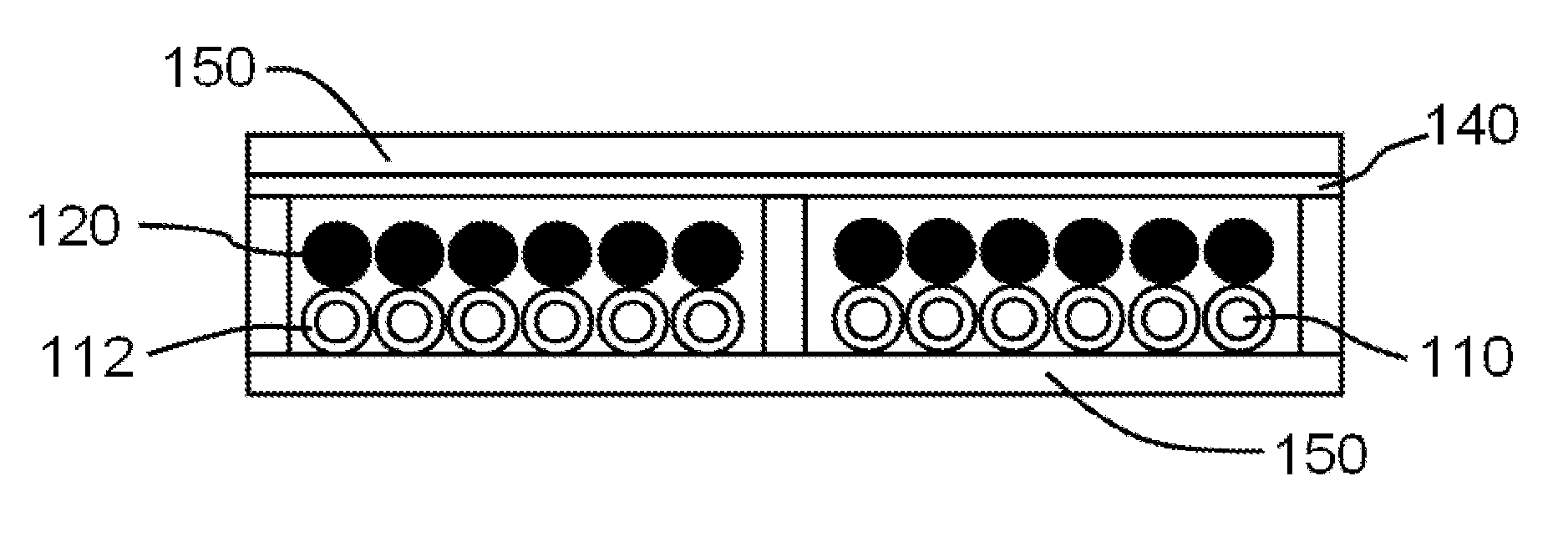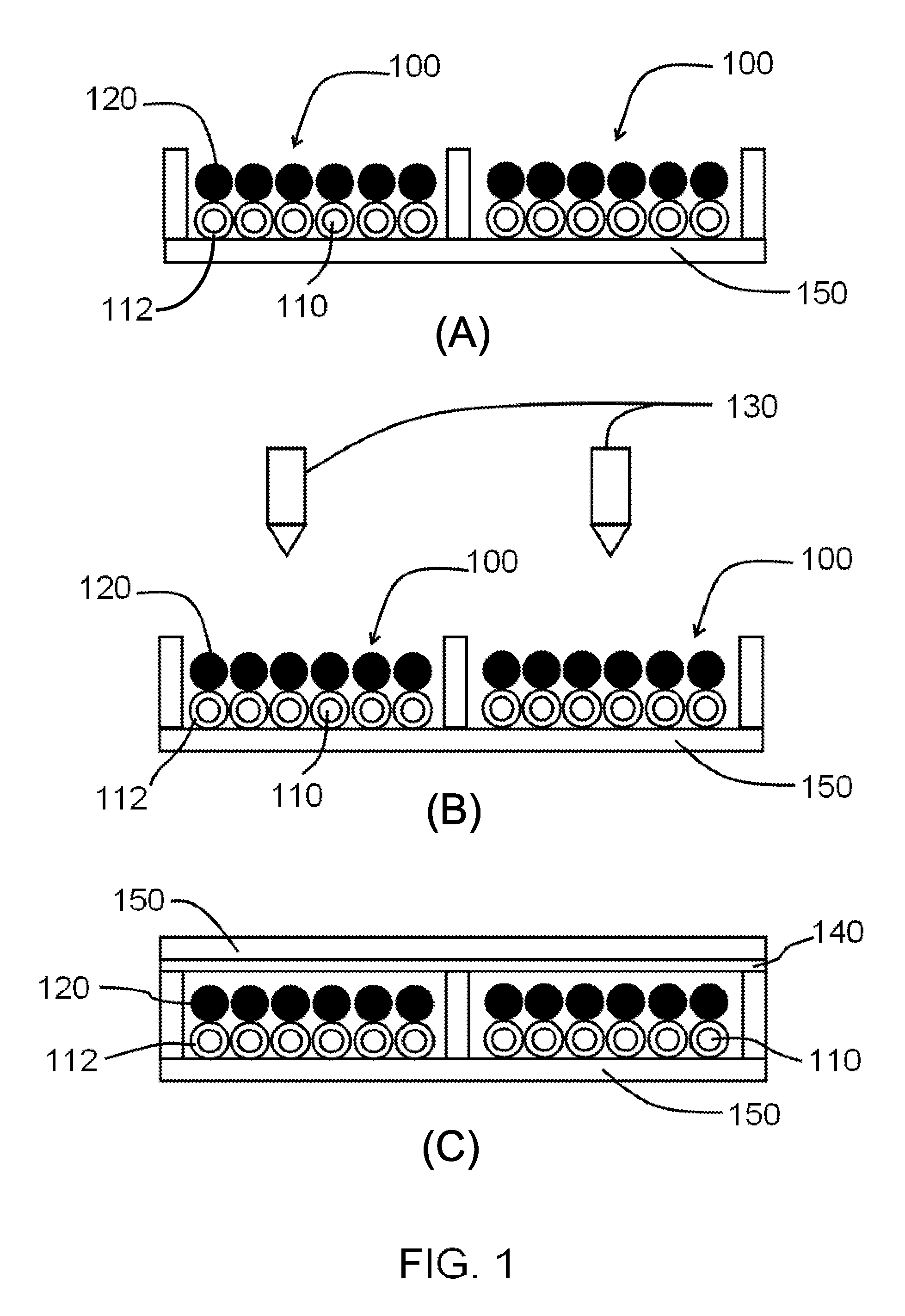Switchable particle-based display and method of manufacturing same
a particle-based display and switchable technology, applied in the field of switchable particle-based display and manufacturing same, can solve the problems of poor chromaticity of the display, difficult uniform filling of pigment particles in the display cells, scattering or splashing of pigment particles from the cells, etc., and achieves the effect of greatly simplifying the sealing of the cell and high densities of charges
- Summary
- Abstract
- Description
- Claims
- Application Information
AI Technical Summary
Benefits of technology
Problems solved by technology
Method used
Image
Examples
example 1
[0084]Desired amounts of polyvinyl pyrrolidone (Sigma-Aldrich), azobis(2-methyl-butyronitrile) (TCI), perfluorodecyl acrylate (Alfa-Aesar) and styrene (Acros) are added into an amount of ethanol and completely dissolved therein to form a first liquid mixture, which is then in a high temperature environment for polymerization for a period of time. Then, separating and drying processes are performed to obtain particles. The obtained particles are coated with TiO2 powders (R102, DuPont) and the charge controlling agent (Bontron E84, Orient), by the dry coating process, to obtain first-type particles with a particle size (D50) about 3.0 μm.
[0085]In addition, desired amounts of polyvinyl pyrrolidone (Sigma-Aldrich), azobis(2-methyl-butyronitrile) (TCI), styrene (Acros), the charge controlling agent (Bontron N07, Orient), and carbon black (Nexon 600, Evonik) are added in an amount of ethanol and mixed homogeneously therein to form a second liquid mixture, which is then in a high temperatu...
example 2
[0087]Desired amounts of polyvinyl pyrrolidone (Sigma-Aldrich), azobis(2-methyl-butyronitrile) (TCI), styrene (Acros), the charge controlling agent (Bontron N07, Orient), and carbon black (Nexon 600, Evonik) are added in an amount of ethanol and mixed homogeneously therein to form a liquid mixture, which is then in a high temperature environment for polymerization for a period of time to obtain black particles with a particle diameter (D50) about 4.0 μm and a charge density about 1 μC / g (210HS-3, Trek). The black particles are corresponding to the second-type particles.
[0088]Further, acrylic resin (CM 205, ChiMei), the charge controlling agent (Bontron E84, Orient) and TiO2 powders (R706, DuPont) are added in a twin screw extruder (MPV 2015, APV) to make composite resin therewith, which is then milled with a milling process (LJ3, NPK) to obtain white particles with a particle size (D50) about 3-6 μm and a charge density −27 μC / g (210HS-3, Trek). The white particles are dispersed in ...
example 3
[0090]Polyvinyl pyrrolidone (Sigma-Aldrich), azobis(2-methyl-butyronitrile) (TCI), 2-hydroxyethyl methacrylate (Acros), divinylbenzene (Sigma-Aldrich) and styrene (Acros) are added into ethanol and completely dissolved therein to form a liquid mixture. The liquid mixture is placed in a high temperature environment for polymerization for a period of time. Then, separating and drying processes are performed to obtain particles. The obtained particles are coated with TiO2 powders (R102, DuPont) and the charge controlling agent (Bontron E84, Orient), by the dry coating process, to obtain the white particles with a particle size about 3.0 μm and a charge density −44 μC / g (210HS-3, Trek). The white particles are then dispersed in water to form a first dispersion solution. Next, perfluorodecyl acrylate (Alfa-Aesar) and potassium persulfate (Acros) are added into the first dispersion solution to perform surface polymerization on the surfaces of the white particles, which are corresponding t...
PUM
 Login to View More
Login to View More Abstract
Description
Claims
Application Information
 Login to View More
Login to View More - R&D
- Intellectual Property
- Life Sciences
- Materials
- Tech Scout
- Unparalleled Data Quality
- Higher Quality Content
- 60% Fewer Hallucinations
Browse by: Latest US Patents, China's latest patents, Technical Efficacy Thesaurus, Application Domain, Technology Topic, Popular Technical Reports.
© 2025 PatSnap. All rights reserved.Legal|Privacy policy|Modern Slavery Act Transparency Statement|Sitemap|About US| Contact US: help@patsnap.com


